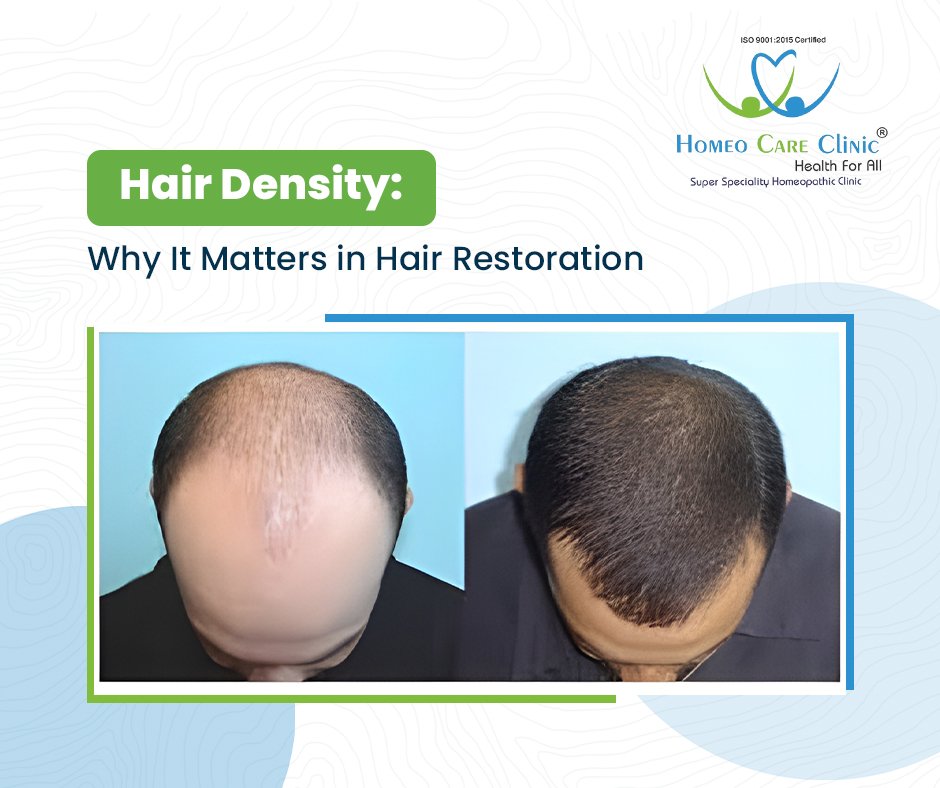Hair Density: Why It Matters in Hair Restoration
When it comes to achieving a full and voluminous head of hair, hair density plays a vital role. It refers to the number of hair strands that grow per square inch on our scalp. It’s neither good nor bad to have high-or low-density hair, it simply is one of the many characteristics of your hair, which can help you determine how best to style your hair. In this blog, let’s understand what hair density is, why it is important, and how it can impact your hair restoration journey.
Hair Loss and Its Impact on Hair Density
Hair loss is a common problem that affects both men and women. Whether your hair loss is driven by genetics, stress, hormonal imbalance, poor hair care, or an underlying medical condition, it can significantly impact one’s self-confidence. Hair density is the number of individual hair strands per square inch on our scalp. It is responsible for giving our hair the overall appearance of being thick or thin and helps us understand the unique characteristics of our hair. Typically, we have around 80,000 to 120,000 hairs on our scalp. Hair density is generally highest at the area at the back of our head, which is also known as the crown. There is no such thing as hair density that is too high or too low, as hair density isn’t indicative of our overall health. However, people with nutritional deficiencies may experience hair loss, which can reduce the overall hair density.
High Density vs. Low Density Hair: Why It Matters
Knowing your hair density can give you an idea of what type of hairstyles and hair products will be suitable for your hair type. If you have low hair density, you should avoid heavy hair products like oils and conditioners that can weigh your hair down. Consider products that can give volume to your hair, like volumising shampoos, dry shampoo, and mousse. Hairstyles that add more volume to your hair can help give your hair a thicker appearance. If your hair density falls somewhere in the middle, you don’t need to do much to change the volume of your hair. Focus on hair products that keep your hair healthy while also experimenting with different hairstyles and products. If you have a higher hair density, you may need heavier styling products like gels and butters to get your hair to stick and keep it under control. Serums and oils may also help reduce frizz. Hairstyles that remove excess bulk may work the best for you. Layering your hair can give an illusion of it being thinner.
Why Is Hair Density Important in Hair Restoration?
Hair density is the most important thing to keep in mind while getting a hair restoration treatment to cure hair loss. Doctors performing hair restoration treatments aim to mimic the natural look of our hair. For a realistic appearance, they need to match the density of the hair as closely as possible. Each follicle needs a consistent blood supply that can provide it with the nutrients necessary to grow healthy hair. Hair restoration treatments like hair transplant involve harvesting the hair follicles from donor sites with higher density, which are then transplanted into the areas of baldness or loss to cover the scalp. The higher your natural hair density, the more donor follicles can be used to replace lost hair. However, if you have a scalp with no hair at all, alternative methods like body hair transplantation, Follicular Unit Extraction, Follicular Unit Transplantation, or other non-surgical treatments like Laser Therapy, PRP therapy, medications, etc., can be considered.
Can You Improve Your Hair Density?
Like many other characteristics of our hair, like colour and texture, hair density is determined by genetics. Our hair grows out of a part of our skin called a hair follicle. You can’t change the number of hair follicles you have. Hair restoration treatments may help to cover patchy areas of hair growth, but if you were born with low hair density, there’s no way to change that. However, you can help maximise your hair density potential by eating a healthy diet. If you have one or more nutritional deficiencies, you may experience hair loss or thinning of your hair. Make sure you eat a well-balanced diet with an adequate protein intake, which can help you prevent deficiencies that may affect hair growth. Some nutrients that play a role in hair growth include biotin, protein, vitamin C, vitamin A, B vitamins, vitamin D, vitamin E, iron, and zinc.
Conclusion
Hair density is responsible for giving our hair the overall appearance of being thick or thin and helps us understand the unique characteristics of our hair. Knowing your hair density can give you an idea of what type of hairstyles and hair products will be suitable for your hair type. With the right hair treatments, you can restore your hair growth and improve hair health. PRP Hair Restoration is suitable for both men and women. It is a state-of-the-art, nonsurgical, totally natural, alternative medical procedure used for the treatment of hair loss or hair thinning. At Homeocare Clinic, we are dedicated to providing our patients with the best quality and personalised treatment plans tailored to fulfill their specific requirements. Our experienced team of dermatologists offers safe, natural, and highly effective solutions to promote the regrowth of our patients’ hair. Contact us now for the best hair treatment in Pune.

